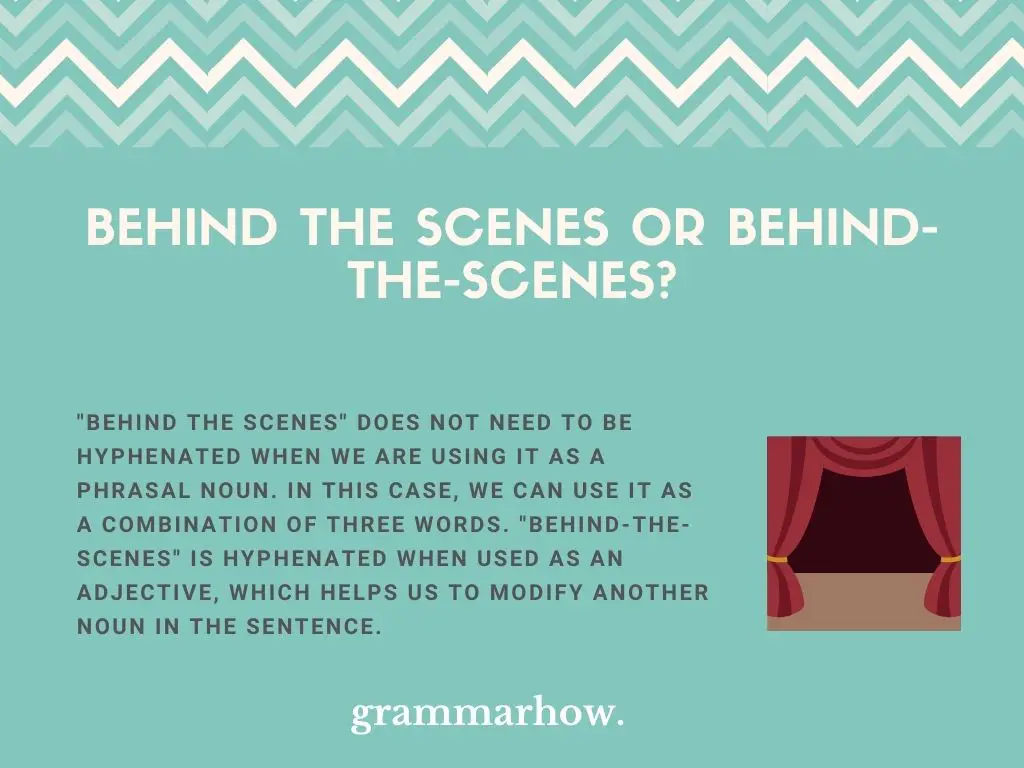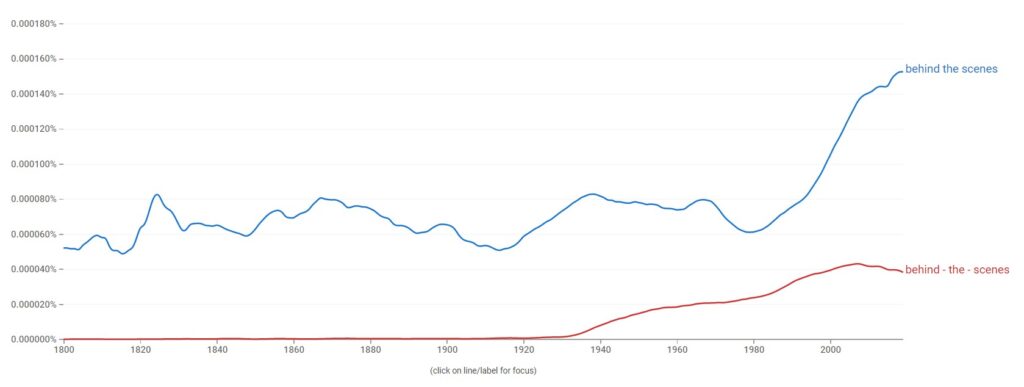Is “behind the scenes” hyphenated? That’s the question we’re looking to answer today. It might help to know whether the hyphen is necessary or whether we can get away with it being a combination of one or two words.
Behind the scenes vs. Behind-the-scenes
“Behind the scenes” does not need to be hyphenated when we are using it as a phrasal noun. In this case, we can use it as a combination of three words. “Behind-the-scenes” is hyphenated when used as an adjective, which helps us to modify another noun in the sentence.

According to Google Ngram Viewer, “behind the scenes” is the much more common variation to use. From this information, we can see that it’s more likely that we’ll use the phrase as a noun rather than a compound adjective.

In The Cambridge Dictionary and The Oxford Dictionary, both recognize “behind-the-scenes” as an official spelling. However, they both state that you should only spell it with the hyphens when it is an adjective.
The dictionaries also teach us that the words “behind the scene” are correct when separated as long as we use it as a phrasal noun. Both variations are official spellings; we just need to know which form works best.
Here’s a helpful tip to remind you:
- Adjective: The behind-the-scenes shoots are taking forever!
- Noun: We don’t know what’s going on behind the scenes.
Behind the scenes
“Behind the scenes” works when we use it as a noun. This is the most common way to write about things that are happening behind the scenes, which is why you’re more likely to use this form. There are often no other nouns present when written in this way.
We use nouns as objects and subjects in the sentence. Adjectives are there to modify them, but “behind the scenes” usually does not need modification. It’s just a way to talk about how things happen while others might not see them.
Here are a few ways the noun phrase works:
- I want to know what’s going on behind the scenes!
- Behind the scenes, there’s definitely a lot more wrong with this situation than anyone is willing to admit.
- Can you talk to me about what was being said behind the scenes?
- If there was anything untoward going on behind the scenes, now is the time to talk about it.
As you can tell, there is no need to hyphenate in this case. We can simply use the noun phrase whenever it makes sense to talk about things that are away from the public eye.
Behind-the-scenes
“Behind-the-scenes” only works when it’s used as a compound adjective. Common English rules teach us that adjectives made of multiple words must be combined if they are working to modify the same noun. That’s why the hyphens are necessary.
The AP Stylebook actually teaches us that all adjectives made of multiple words must be linked somehow. The best way to link them is through hyphens, and the noun can come before or after the adjective depending on the context.
It might help you to see how the adjective form works differently from the noun:
- The behind-the-scenes clips are always the most interesting to me.
- I am a behind-the-scenes photographer, and they pay me big bucks for it.
- Whatever the behind-the-scenes directors said to you, ignore it.
- I think they’re having behind-the-scenes meetings about us.
As you can see, when using it as an adjective, it’s common to see the noun come directly after the hyphenated phrase. This is done to show that something is being modified, and it’s a common way to write in English.
Is “The-Scenes” Capitalized In The Word “Behind-The-Scenes”?
While it’s not the most common form of spelling, it might help to know more about capitalizing “behind-the-scenes” when hyphenated.
You do not need to capitalize “the-scenes” at the end of the word because we do not use it as a proper noun. The only time where it might be appropriate is when you write it in a title, and all the other words are capitalized.
This situation will only come up if you choose to capitalize every word in your titles (which is a stylistic choice). In this case, you can treat the three words separately and capitalize them all (even though they’re hyphenated into one word).

Martin holds a Master’s degree in Finance and International Business. He has six years of experience in professional communication with clients, executives, and colleagues. Furthermore, he has teaching experience from Aarhus University. Martin has been featured as an expert in communication and teaching on Forbes and Shopify. Read more about Martin here.

